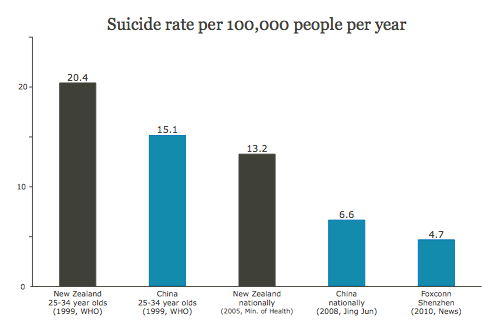All suicides are tragic — but is the suicide rate at the iPhone factory unusual?
Over the last few years, Chinese manufacturer Foxconn has attracted attention from the international media for a spate of suicides in its factories. Foxconn makes products for Apple, including the iPhone and iPad, and manufactures for Sony, Zoostorm, Dell, and Nokia. It employs 1.2 million people in China, with its factory in Shenzhen employing 300,000 people alone.
Articles such as “Another Foxconn worker commits suicide” (NZ Herald 21 July 2011) blame working conditions and long hours of work for the number of suicides. Last year, 14 Foxconn employees committed suicide – most jumped to their deaths – resulting in the company installing netting around the factory and dormitory buildings.
Undoubtedly the working conditions are tough at Foxconn, but what do we make of this suicide rate? Is the suicide rate at Foxconn a lot higher than the suicide rate in the whole population? You’d think so, from all the media attention.
What is the suicide rate in China? It’s actually quite difficult to get a sense of the actual rate, as official figures and independent sources vary wildly from 6.6 to 30.3 per 100,000 per year. (Jing Jun, 2008, Samuel Law and Pozi Liu, 2008) For comparison, New Zealand’s suicide rate is roughly 13 suicides per 100,000 people per year (WHO, 1999, Ministry of Health, 2005).
Even if we take the lowest reported rate of 6.6 per 100,000 people per year, the Foxconn suicide rate among its mammoth workforce of 1.2 million is well below this rate. Taking a conservative view, if the 14 suicides in 2010 occurred amongst Foxconn’s 300,000 workers in Shenzhen, the rate works out to 4.7 per 100,000 people per year.
Another factor that could be at play is age. The people working at Foxconn would be young, say in the 25-34 year old group, and we know that this age group in New Zealand has a higher suicide rate than others. Surprisingly, this does not appear to be the case in China, where elderly people tend to have a higher suicide rate. (Jing Jun, 2008, WHO, 1999)
While each Foxconn suicide is a tragedy, with such a large workforce 14 suicides in 2010 is neither unexpected nor unusual. If anything, Foxconn’s workers have a lower suicide rate than could be expected, on average, amongst their peers.
The newspaper reports infer that there is a link between suicides and working conditions, and that the number of suicides is unusual.
Disclaimer: There are many complex cultural and sociological factors at work, as well as pressures that inflate or deflate reported data from China.

Recent comments on Maxine Pfannkuch’s posts